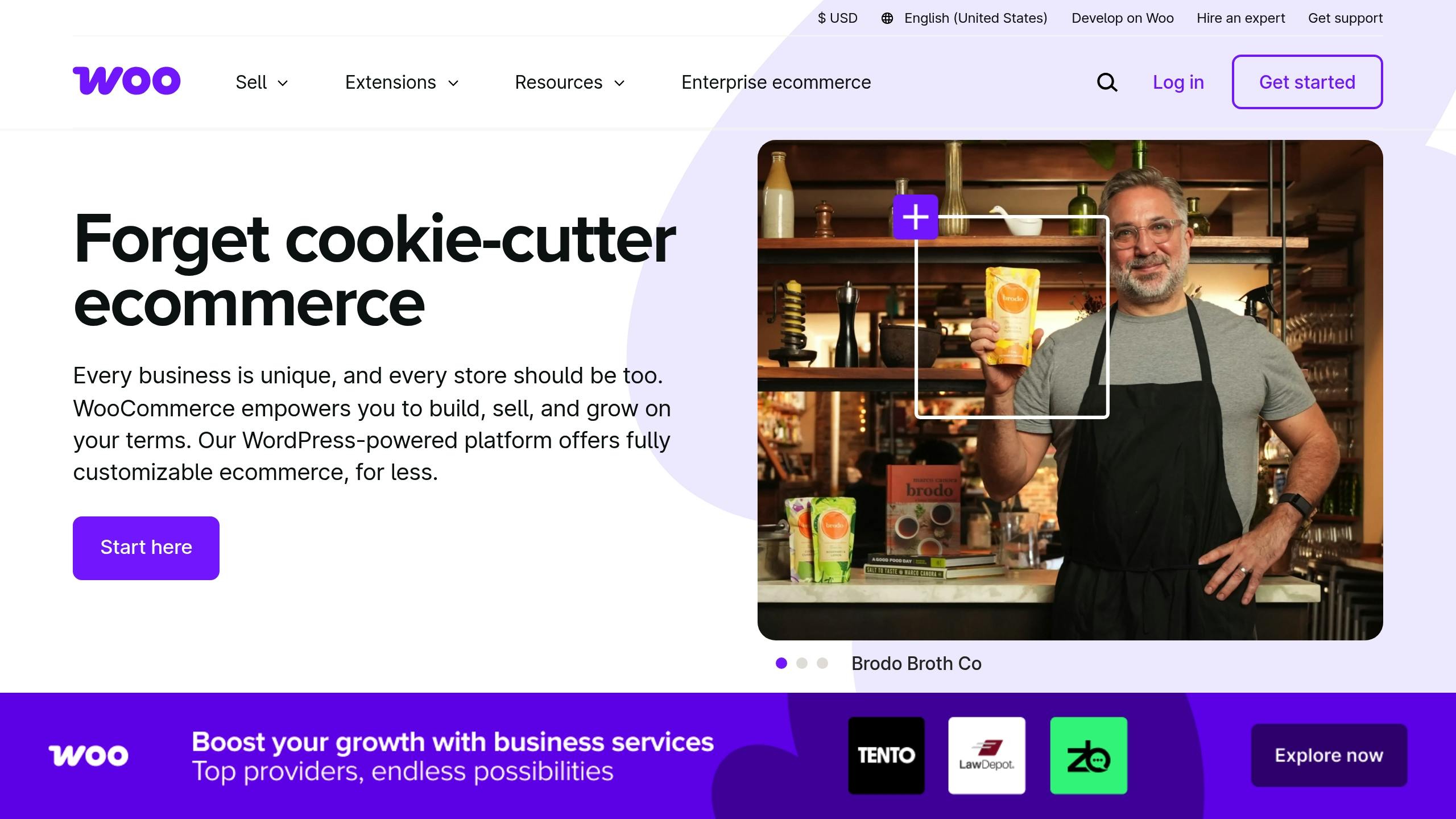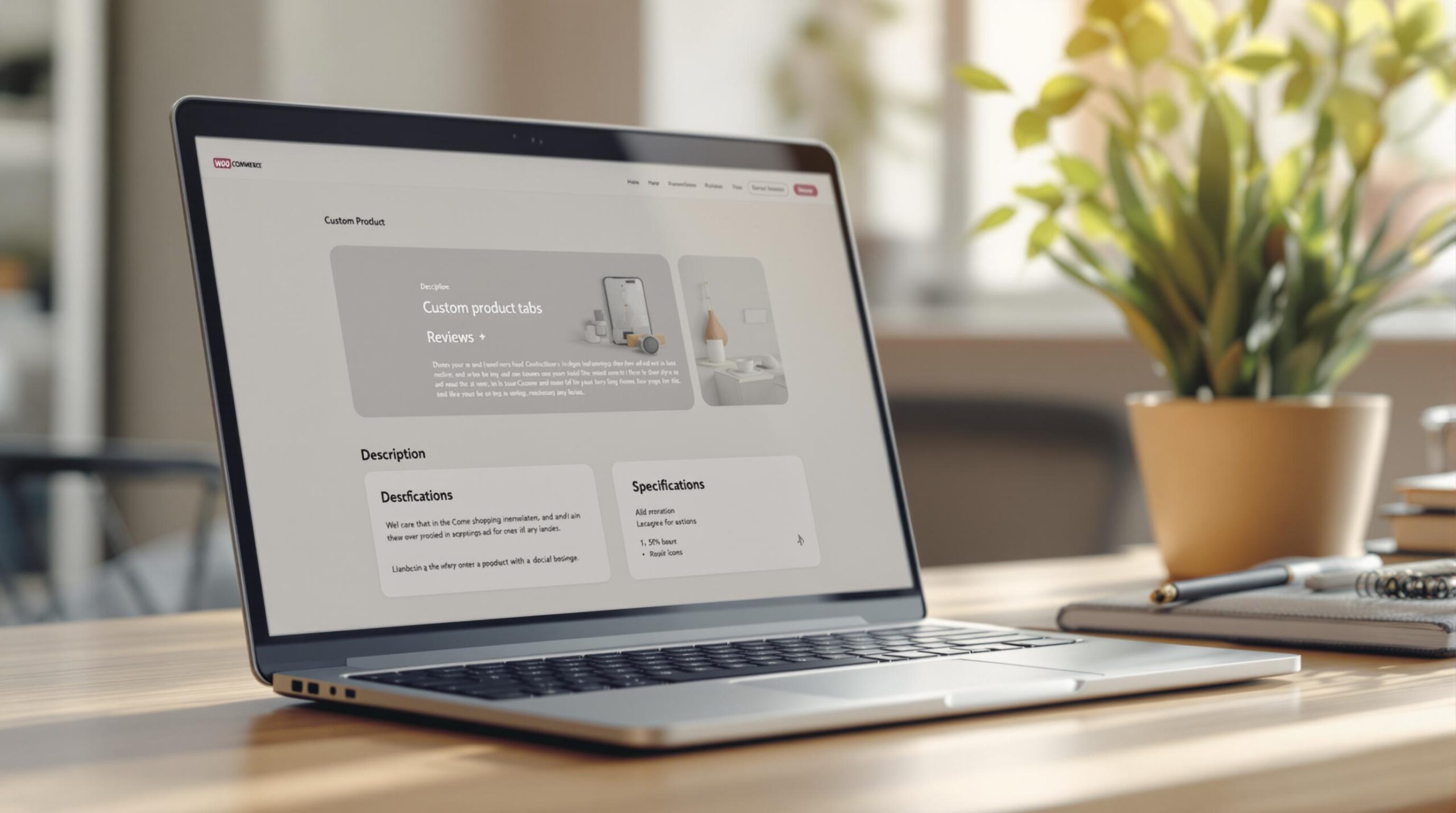-
Why Use Custom Tabs?
They make information easier to find, improve navigation, and provide extra space for keywords to help with search rankings. -
How to Add Them:
- Code: Add snippets to your child theme for full control.
- Plugins: Use tools like WooCommerce Product Tabs for a no-code solution.
Quick Comparison: Plugins vs. Custom Code
| Feature | Plugins | Custom Code |
|---|---|---|
| Ease of Use | No coding required | Requires PHP knowledge |
| Setup Speed | Quick | Time-intensive |
| Features | Pre-built options | Fully customizable |
| Maintenance | Automatic updates | Manual upkeep |
Custom tabs can include anything from size guides to technical specs, tailored to your product needs. Choose the approach that works best for your skill level and store requirements.
How to Add Custom Tabs & Data in Product Page
WooCommerce Product Tabs Basics

WooCommerce provides three default product tabs. Here’s a breakdown of these tabs and how custom tabs can improve your product pages.
Standard Tab Options
Every WooCommerce product page includes three default tabs:
- Description Tab: Displays the main product description.
- Additional Information Tab: Highlights product details like weight, dimensions, and specifications.
- Reviews Tab: Features customer reviews and ratings.
The way these tabs look may vary depending on your theme, but their core functionality stays the same. These default tabs lay the groundwork for adding custom tabs to better showcase your products.
When to Use Custom Tabs
Default tabs handle the basics, but custom tabs are perfect for products requiring extra details:
- Clothing & Accessories: Add size charts, care instructions, or additional reviews.
- Electronics: Include technical specifications, warranty details, or FAQs.
- Beauty Products: Share ingredient lists, application tips, or safety guidelines.
How Custom Tabs Improve Product Pages
Custom tabs make product pages more user-friendly by:
- Organizing information neatly without overwhelming the layout.
- Separating different types of content for easier navigation.
- Improving the browsing experience, especially on mobile devices.
Tips for Effective Custom Tabs:
- Use clear and descriptive tab names.
- Keep the tab layout consistent across products.
- Regularly update the content to keep it relevant.
- Track customer interaction to see what works best.
Method 1: Custom Tabs Using Code
Using custom code allows you to have complete control over WooCommerce product tabs, giving you the ability to tailor them exactly as needed.
Adding Your First Custom Tab
To create a custom tab, insert the following code into your child theme’s functions.php file:
add_filter('woocommerce_product_tabs', 'add_custom_product_tab');
function add_custom_product_tab($tabs) {
$tabs['custom_tab'] = array(
'title' => 'Specifications',
'priority' => 50,
'callback' => 'custom_tab_content'
);
return $tabs;
}
function custom_tab_content() {
echo '<h2>Product Specifications</h2>';
echo '<p>Your custom content goes here.</p>';
}
This example creates a "Specifications" tab with a priority of 50, placing it after the Reviews tab.
Show Tabs for Specific Products
If you want the custom tab to appear only for certain products, use a conditional check in your code. For example:
function add_category_specific_tab($tabs) {
if (has_term('ponchos', 'product_cat')) {
$tabs['size_guide'] = array(
'title' => 'Size Guide',
'priority' => 40,
'callback' => 'size_guide_content'
);
}
return $tabs;
}
This code ensures the "Size Guide" tab only appears for products categorized under "ponchos."
"You should place custom PHP in functions.php and custom CSS in style.css of your child theme: where to place WooCommerce customization?" – Rodolfo Melogli, Business Bloomer Founder
Code Safety Guidelines
To ensure your customizations are secure and maintainable, follow these best practices:
- Use a Child Theme: Always add custom code to a child theme to avoid losing changes during updates.
- Test in Staging: Test your custom tabs on a staging site before deploying them to your live store.
- Stay Organized: Keep your functions well-documented and structured for easier updates and troubleshooting.
Practical Example
In July 2024, WisdmLabs showcased how adding a custom "Additional Information" tab improved product page organization. This change led to cleaner layouts and better information flow.
"Custom tabs let you showcase detailed product info, manage out-of-stock items better, and keep your product pages looking clean and professional." – Aruna Vadlamani, WisdmLabs
Pro Tips for Implementation:
- Assign tab priorities in increments of 10 (e.g., 10, 20, 30) to simplify reordering.
- Document your code thoroughly to make future maintenance easier.
sbb-itb-e45557c
Method 2: Custom Tabs Using Plugins
WooCommerce tab plugins make it easy to add custom product tabs without writing a single line of code.
Top Tab Plugins
Here are three popular plugins to consider:
| Plugin Name | Free Features | Premium Features | Rating |
|---|---|---|---|
| YITH WooCommerce Tab Manager | Add unlimited global tabs | Product-specific tabs, multimedia content, forms | 3/5 |
| WooCommerce Product Tabs | WYSIWYG editor, category-based tabs | Icon support, drag-and-drop ordering | 4.7/5 |
| WPB Product Tabs Manager | Basic content types, tab rearrangement | Conditional tabs, Elementor integration | 4.5/5 |
WooCommerce Product Tabs has gained popularity with over 10,000 active installations, making it a go-to choice for many store owners.
Plugin Setup Guide
Follow these steps to get started with a plugin:
- Install and activate the plugin via Plugins > Add New in your WordPress dashboard.
- Navigate to the plugin settings under the WooCommerce menu.
- Use the WYSIWYG editor to create a new tab.
- Set the tab’s visibility (global, category-specific, or product-specific).
- Arrange tabs by setting their priority or using drag-and-drop functionality.
"WooCommerce Product Tabs lets you add an unlimited number of extra tabs to any or all of your product pages." – WooCommerce Product Tabs Plugin Description
Plugins vs. Custom Code
Wondering whether to use a plugin or write custom code? Here’s a quick comparison:
| Aspect | Plugins | Custom Code |
|---|---|---|
| Technical Skill | Minimal – no coding needed | Advanced – requires PHP and HTML knowledge |
| Setup Time | Quick – just a few minutes | Slower – involves development |
| Features | Pre-built options with regular updates | Limited by coding skills |
| Compatibility | Low risk – plugins are tested | Higher risk – potential for conflicts |
| Maintenance | Automatic updates | Requires manual upkeep |
For instance, WPB Product Tabs Manager includes features like conditional tabs and Elementor integration, which would take significant time and expertise to replicate through custom coding. Similarly, premium plugins like WooCommerce Product Tabs Pro offer advanced options, such as making tab content searchable, that would require complex development work.
Using plugins is a time-saving and efficient way to add and manage custom tabs, offering a solid starting point for enhancing your product pages.
Advanced Tab Features
Adding Live Content
Dynamic tabs can make product pages more interactive by showing live data. The premium version of WPC Product Tabs for WooCommerce lets you create tabs with features like real-time stock updates, user-specific pricing, and personalized content tailored to customer roles.
Here’s how you can use dynamic content:
- Shortcode Integration: Add shortcodes to display live inventory or pricing directly.
- Role-Based Content: Configure tabs to show different details based on membership levels or user roles.
- Live Updates: Highlight real-time stock statuses, shipping estimates, or promotional countdowns.
Custom Field Display
Custom fields help present product details in an organized way. Here’s a quick guide:
| Product Type | Suggested Custom Fields | Display Style |
|---|---|---|
| Electronics | Screen size, connectivity, resolution | Structured table |
| Apparel | Size, material, care instructions | Bullet points |
| Industrial | Technical specs, certifications | Downloadable PDFs |
| Digital | Version, compatibility, features | Organized list |
For instance, Universal Fans uses custom tabs to clearly present technical specs for their electrical fans. Their product pages include key details like motor capacity, wattage, noise level, and IP rating in an easy-to-read table format. If you run into challenges with these features, the troubleshooting tips below can help.
Fix Common Problems
Advanced features sometimes come with hiccups. If you face issues with custom tabs, try these solutions:
-
Plugin Conflicts
Turn off all plugins except WooCommerce and your tab plugin. Switch to a default theme, then reactivate plugins one at a time to find the conflict. -
Performance Issues
Adjust server settings likemax_execution_timeandmax_allowed_packetto improve tab loading speeds. Keep an eye on RAM usage and check logs under WooCommerce > Status. -
Content Display Problems
Ensure your HTML structure is valid, verify WooCommerce template compatibility, double-check shortcodes, and monitor page loading times.
Summary of Insights and Actionable Steps
Key Takeaways
Custom product tabs can greatly improve WooCommerce product pages. You can opt for custom code if you want full control, or use plugins for a simpler, no-code approach. Each option has its strengths:
| Aspect | Custom Code Solution | Plugin-Based Solution |
|---|---|---|
| Flexibility | Offers complete control and customization | Limited to the plugin’s built-in features |
| Ease of Use | Requires coding knowledge | Suitable for non-coders |
| Development | Time-intensive and manual | Faster setup with user-friendly tools |
| Performance | Can be fine-tuned for speed | Depends on the plugin’s code quality |
| Maintenance | Requires manual updates and testing | Handled by plugin developers |
| Cost | Free aside from development time | Ranges from free to premium |
Practical Steps to Maintain Custom Tabs
To ensure your custom tabs work smoothly over time, consider these maintenance practices:
- Regular Maintenance: Check for compatibility issues at least once a month.
- Security Updates: Rigorously validate any user-entered data to prevent vulnerabilities.
- Backup Strategy: Always automate backups before making changes.
Additionally, establish a testing routine to avoid surprises:
- Test tab functionality after every update.
- Confirm that custom fields display correctly across all products.
- Use tools like GTmetrix to monitor and optimize load times.
These steps will help keep your WooCommerce product pages running efficiently and effectively.


Leave a Reply